
Leczenie światłem – wiadomości ogólne
Bioptron to system terapii światłem spolaryzowanym. Nazwa pochodzi od szwajcarskiej firmy Bioptron AG. Urządzenie Bioprton emituje światło o widmie podobnym do wytwarzanego przez słońce, ale bez promieni UV. Światło to ma działanie biostymulacyjne, pobudza układ immunologiczny i procesy regeneracyjne. Zabieg charakteryzuje się tym, że jest nieinwazyjny i bezpieczny.
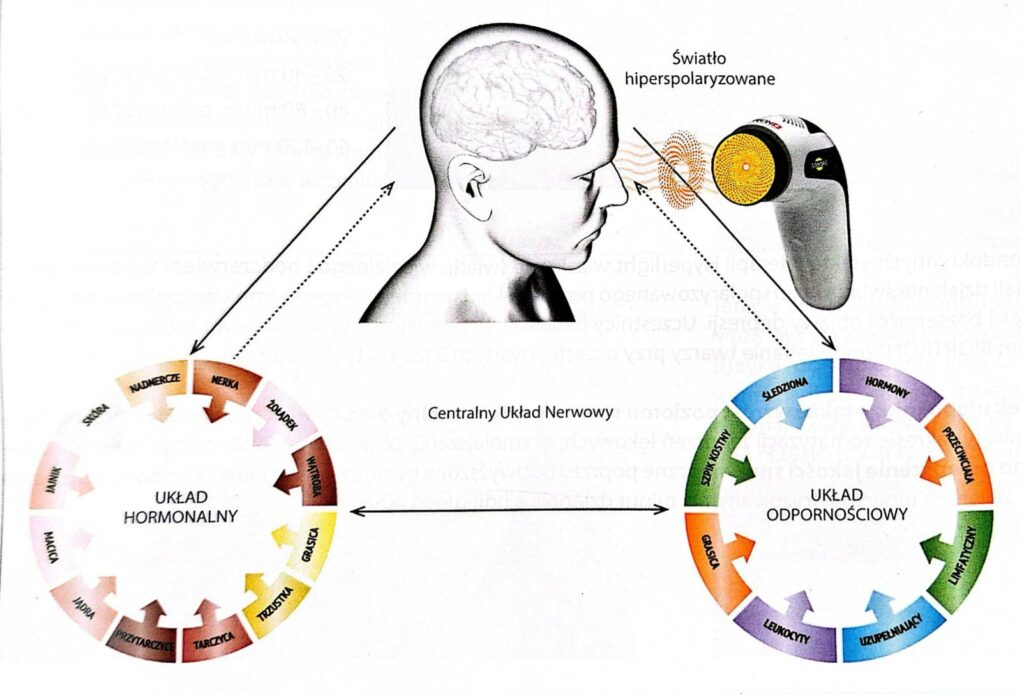
Lampa Bioptron działa poprzez emitowanie światła spolaryzowanego, które wnika w głąb skóry i pobudza komórki do regeneracji. Światło to ma właściwości biostymulacyjne. Dzięki różnym długościom fal, przenikają ono przez tkanki na odmienną głębokość i pobudzają procesy regeneracyjne organizmu. Lampa bioptron aktywizuje układ odpornościowy, przyspiesza metabolizm, działa przeciwzapalnie i przeciwbólowo. Dodatkowo bioptron wykazuje silne działanie biostymulacyjne, co pomaga w leczeniu kontuzji, schorzeń, dolegliwości bólowych narządu ruchu. Wzmacnia również odporność, przyspiesza regenerację struktur oraz wspomaga regulację poziomu hormonów, takich jak melatonina i serotonina. Przyczynia się to niewątpliwie do poprawy samopoczucia, nastroju i funkcjonowania naszego organizmu.
Bioptron generuje światło w spektrum widzialnym i częściowo podczerwonym, rozciągającym się od 480 nm do 3400 nm, czyli 1,15–2,90 eV (ze szczytem przy wartości 720 nm, tj. 1,70 eV) ). Dostarcza spójną wiązkę światła ze stałą intensywnością (określaną także jako gęstość mocy) o wartości 40 mW/cm2 z odległości 10 cm od obszaru poddawanego zabiegowi. Dozowanie światła BIOPTRON można określić bardzo szczegółowo, ponieważ światło BIOPTRON składa się z dwóch komponentów, czyli mocy i czasu: energia (J) = moc (W) × czas (s) (prawo Bunsena i Roscoe’a wzajemności w fotobiologii), co pozwala światłu na penetrację głęboko przez tkanki, aktywując i promując różnorodne procesy komórkowe i biologiczne, które przyśpieszają lecznicze procesy regeneracyjne i naprawcze.

Światło może być spolaryzowane na dwa sposoby:
- Polaryzacja VLPL (Very Low Polarization) to stan polaryzacji światła, w którym drgania fali są ograniczone do jednej płaszczyzny. Jest to rodzaj polaryzacji liniowej z mniejszą intensywnością drgań.
- Światło hiperspolaryzowane („Quantum Hyperlight”) to specjalnie przetworzone światło, emitowane przez lampy z filtrem fulerenowym. Jest to forma światła spolaryzowanego, dodatkowo wzbogacona o unikalne właściwości wynikające z oddziaływania z fulerenem C60.
Światło po przejściu przez filtr z fuleronem C60 przyjmuje kształt kwantowej struktury toroidalnej, która posiada cechy zarówno fizyki kwantowej, jak i geometrii toroidalnej. Geometria toroidalna to termin odnoszący się do kształtu torusa, czyli powierzchni obrotowej powstającej przez obrót koła wokół osi, która jest współpłaszczyznowa z tym kołem. Z geometrycznego punktu widzenia torus jest trójwymiarowym obiektem przypominającym obwarzanek.

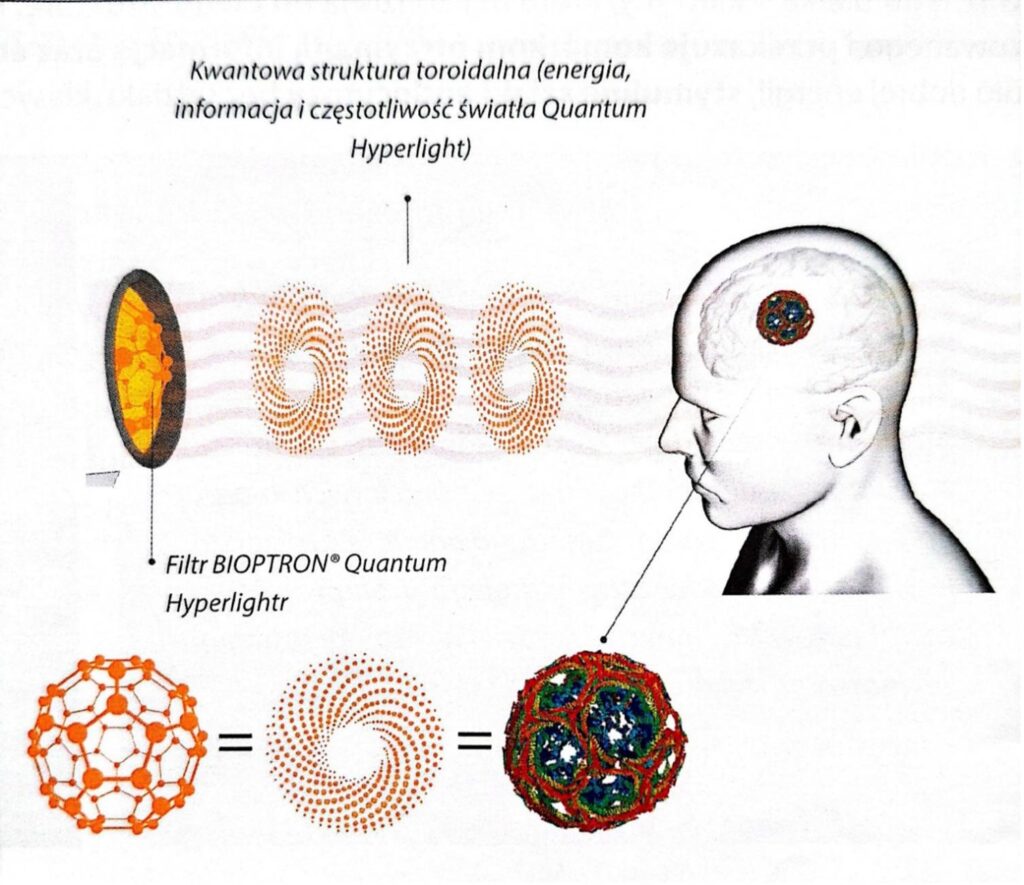

Cechy światła Bioptron
- Polaryzacja – światło emitowane przez urządzenie osiąga polaryzację na poziomie 95%.
- Polichromia – szeroki zakres fal obejmujący światło widzialne oraz część zakresu podczerwieni (zakres widma 480 – 3400 nm). Nie ma ryzyka niekorzystnych efektów promieniowania UV, ponieważ światło nie zawiera tych promieni.
- Niespójność (niekoherencja) – niezsynchronizowane fale świetlne.
- Niska energia – średnia gęstość energetyczna 2,4 J/cm2, co daje działanie biostymulacyjne. Obszar ciała leczony jest ze stałą i stabilną intensywnością.
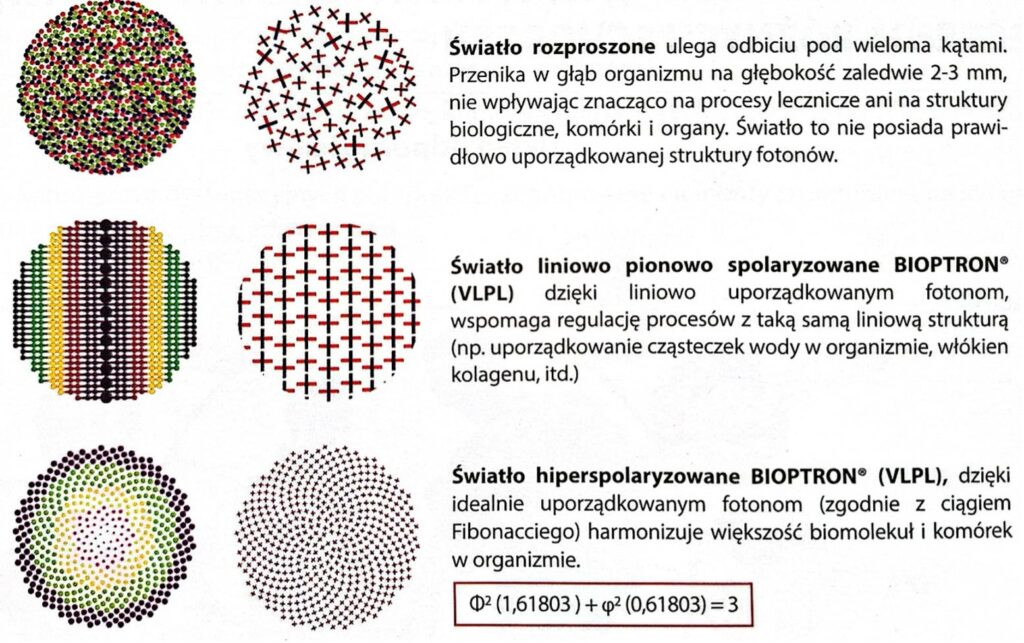
Do głównych zalet światła Bioptron zalicza się szeroki zakres zastosowania, łatwość użycia, krótki czas terapii, która jest całkowicie bezbólowa. Dodatkowo to ekonomiczność pod względem kosztów oraz bezpieczeństwo i nieinwazyjność.
Podobieństwo typów symetrii fuleronu C60 i licznych struktur biochemicznych organizmu stwarza warunki do szczególnej interferencji pomiędzy światłem hiperspolaryzowanym a tkankami zawierającymi te struktury. Te warunki można nazwać „biologiczną matrycą”, za pomocą której energia fotonów wnika w struktury komórkowe porządkując je i nadając im odpowiedniej energii.
Bioptron – działanie
Spolaryzowane światło Bioptronu wnika w głąb ciała gdzie pobudza światłoczułe struktury wewnątrzkomórkowe. Różnice w głębokości przenikania struktur ciała w zależności od długości fali (koloru światła) i stopnia spolaryzowania światła.
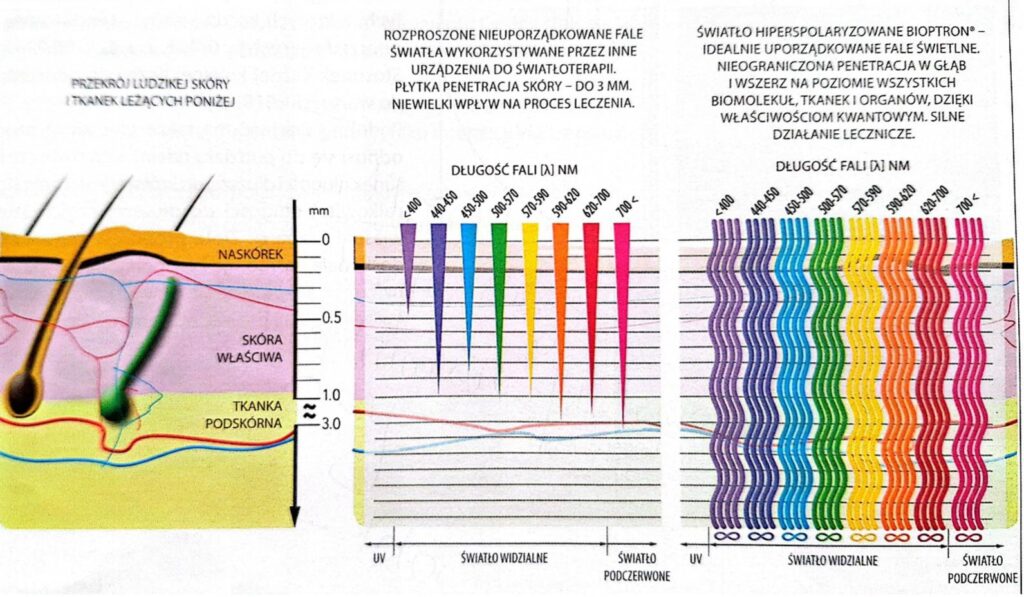
Główne efekty lecznicze stwierdzone przez liczne badania naukowe, to między innymi:
- wzrost odporności,
- działanie przeciwbólowe, przeciwzapalne,
- przyspieszenie procesów metabolicznych,
- poprawę mikrocyrkulacji w skórze,
- stymulację procesów regeneracyjnych i odtwórczych całego organizmu,
- przyspieszenie gojenia się ran,
- poprawa jakości snu,
- zwiększenie zakresu ruchomości w stawach.
Bioptron – wskazania
Głównymi wskazaniami klinicznymi do leczenia światłem spolaryzowanym są:
- bliznowce;
- ból kręgosłupa;
- bóle neuralgiczne;
- bóle mięśniowe;
- dyskopatia;
- zapalenie korzeni nerwowych;
- choroby stawów;
- depresja;
- choroba Burgera;
- cukrzyca;
- dermatozy;
- oparzenia;
- pielęgnacja ran pooperacyjnych;
- odleżyny;
- owrzodzenia;
- półpasiec;
- żylaki;
- starzenie się skóry,
- i inne.
Terapia światłem Bioptron może być stosowana jako uzupełnienie leczenia chorób reumatycznych – np. reumatoidalnego zapalenia stawów, wszelkich schorzeń urazowo-ortopedycznych oraz w medycynie sportowej.
Lampa Bioptro umożliwia także tzw. „koloroterapię”. Wykorzystywane jest w niej zjawisko odmiennej reakcji organizmu człowieka na różne zakresy światła widzialnego.
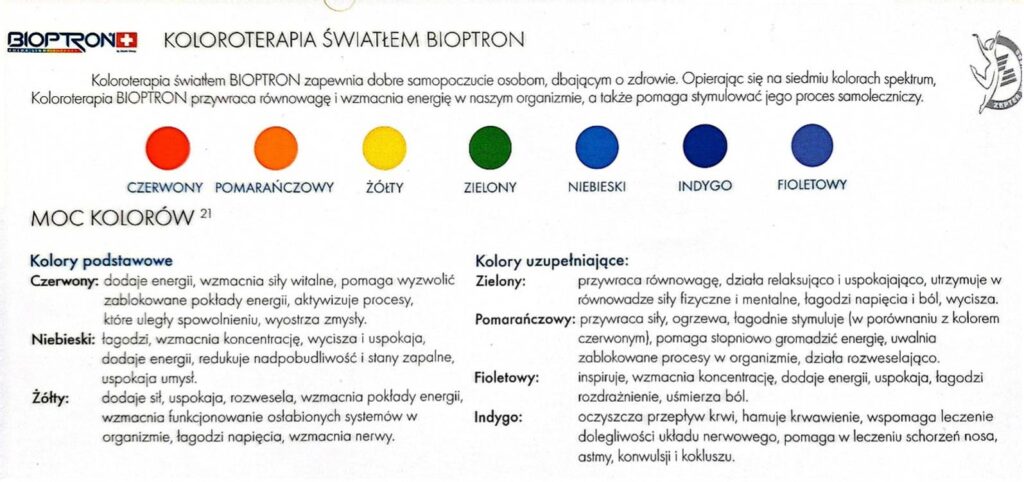
Terapię można stosować 1-2 razy dziennie, np. codziennie rano i wieczorem. Czas trwania waha się zwykle od 4 do 10 minut w zależności od wskazań. Producent opracował precyzyjny harmonogram zabiegów w zależności od rodzaju schorzenia lub dolegliwości. Plan można modyfikować biorąc pod uwagę indywidualne uwarunkowania.
Nie stwierdzono skutków ubocznych do stosowania terapii światłem Bioptron.
Lista źródeł naukowych
- Kwon, J., Kim, Y., Lanuza, A. et al.Powstawanie polarytonów materia-fala w sieci optycznej. Nat. Phys. (2022).
- T.Kubasova, M.Horvath, K. Kocsis and M.Fenyö: Wpływ światła widzialnego na niektóre parametry komórkowe i odpornościowe. Immunology and Cell Biology, 1995, 73; 239-244.
- M.Fenyö, J.Mandl and A.Falus: Działanie przeciwne światła liniowo spolaryzowanego na biosyntezę interleukiny-6 w linii ludzkich komórek limfoidalnych B i ludzkich monocytach z krwi obwodowej. Cell Biology International, 2002, 26(3); 265-269.
- T.Kubasova, M.Fenyö, Z.Somosy, L.Gazso and I.Kertesz: Badania nad działaniem biologicznym światła spolaryzowanego, 1988, 48; 505-509.
- P.Bolton, M.Dyson and S.Young: Wpływ światła spolaryzowanego na uwalnianie czynników wzrostowych z linii U-937 komórek makrofagopodobnych. Laser Therapy, 1992, 2(3); 33-37.
- I.Kertesz, M.Fenyö, E.Mester and G.Bathory: Hipotetyczny model fizyczny dysymulacji lasera. Optics and Laser Technology, 1982, 16; 31-32.
- K.A.Samoilova, K.D.Obolenskaya, A.V.Vologdina, S.A.Snopov and E.V.Shevchenko: Jedno naświetlenie skóry światłem widzialnym wywołuje gwałtowne modyfikacje w całej krwi krążącej – 1. Poprawa parametrów reologicznych i immunologicznych. Progress in Biomedical Optics/Proceedings of Low-Power Light on Biological Systems, 1998, IV; 90-103.
- J.E.Roberts: Światło widzialne wywołuje zmiany w odpowiedzi immunologicznej poprzez działanie mechanizmu oko-mózg (fotoneuroimmunologia), Journal of Photochemistry and Photobiology, B: Biology, 1995, 29(1); 3-15.
- Al-Kader, Ahmed Mamdouh Mohamed Abd; Hassan, Maha A; Elsayed Hisham, Galal Mahran; Mowafy Zakaria Mowafy Emam. JMSCR Volume 03 Issue 05 May 2015
- El-Deen, Heba Bahey; Fahmy, Seham; Ali, SA; El-Sayed, W.M. Polarized light versus light-emitting diode on healing of chronic diabetic foot ulcer. Romania, J. BIOPHYS., Tom. 24, Nr. 2, P. 000–000, Bukarest, 2014
- L. Medenica and M. Lens: The use of polarised polychromatic non-coherent light alone as a therapy for venous leg ulceration. Journal of Wound Care, 2003, 12(1); 37-40.
- S. Monstrey, H. Hoeksema, H. Saelens, K. Depuydt, M. Hamdi, K. Van Landuyt and P. Blondeel: A conservative approach for deep dermal burn wounds using polarised-light therapy. British Journal of Plastic Surgery, 2002, 55; 420-426.
- P. Iordanou, G. Baltopoulos, M. Giannakopoulou, P. Bellou and E. Ktenas: Effect of polarized light in the healing process of pressure ulcers. International Journal of Nursing Practice. International Journal of Nursing Practice, 2002, 8(1); 49-55.
- S. Monstrey, H. Hoeksema, K. Depuydt, G. Van Maele, K. Van Landuyt and P.Blondeel: The effect of polarized light on wound healing. European Journal of Plastic Surgery, 2002, 24(8); 377-382. Komentarz gościnny: W.Vanscheidt The effect of polarized light on wound healing. European Journal of Plastic Surgery, 2002, 24(8); 383.
- Colic MM, Vidojkovic N, Jovanovic M, Lazovic G. The use of polarized light in aesthetic surgery. Aesthetic Plast. Surg. 2004; 28(5):324-7.
- Tomashuk IP, Tomashuk II. [Clinical efficacy of alprostan in combination with „Bioptron-II” rays and iruxol-miramistin in the treatment of the diabetic foot complicated by atherosclerosis]. Klin.Khir. 2001;(8):49-51.
- Aragona SE, Grassi FR, Nardi G, Lotti J, Mereghetti G, Canavesi E, Equizi E, Puccio AM , Lotti T. Photobiomodulation with polarized light in the treatment of cutaneous and mucosal ulcerative lesions. J Biol Regul Homeost Agents 2017;31:213-8.
- Białożyt J., Materniak K., Kawecki M. 2018 Zastosowanie światła polaryzowanego we wspomaganiu leczenia odleżyn u pacjentów po oparzeniach. Raport wstępny. Dermatologia Estetyczna. vol. 20, 1 (114)
- Bolton P., Dyson M., Young S. The effect of polarized light on the release of growth factors from the U-937 macrophage-like cell line. J-STAGE/ Laser therapy, 1992 – / Tom 4 (1992) Wyd. 1
- De Melo CA, Alves AN, Terena SM, Fernandes KP, Nunes FD, da Silva Dde F, Bussadori SK, Deana AM, Mesquita-Ferrari RA. Light-emitting diode therapy increases collagen deposition during the repair process of skeletal muscle. Lasers Med Sci. Kwiecień 2016 ;31(3):531-8.
- Falus A, M. Fenyo M, Eder K, Madarasi A. Genome-wide gene expression study indicates the anti-inflammatory effect of polarized light in recurrent childhood respiratory disease. Inflamm. Res. (2011) 60: 965.
- Fenyö M., Mandl J., Falus A. Opposite effect of linearly polarized light on biosynthesis of interleukin-6 in a human b lymphoid cell line and peripheral human monocytes. Cell Biology International, 1992 Tom 26, Wyd. 3, P.265-269
- Gasparyan LV, Brill G, Makela AM – Activation of angiogenesis under influence of red low level laser radiation Proceedings Volume 5968 , Laser Florence 2005: A Window on the Laser Medicine World; 596806
- Karu TI, Pyatibrat LV, Afanasyev NI. A Novel Mitochondrial Signaling Pathway Activated by Visible-to-near Infrared Radiation Photochemistry and Photobiology, 2004, 80: 366-372
- Karu, Kolyakov SF Exact action spectra for cellular responses relevant to phototherapy. Photomedicine and Laser Therapy, 2005, Volume 23, Number 4, Pp. 355-361
- Kislyi ND (2009) BIOPTRON Light Therapy in Dermatocosmetology. Guideline of the Federal Educational Agency / Russian People’s Friendship University, Moscow 2009
- Kolenko 2017 Light therapy in complex treatment of patiens with herpes zoster. National Medical University named after O.O. Bogomolets, Kiev, Ukraine
- Kubasova T, Horváth M, Kocsis K, Fenyö M. Effect of visible light on some cellular and immune parameters. Immunology and Cell Biology (1995) 73, 239-244
- Lavi R, Shainberg A, Friedmann H, Shneyvays V, Rickover O, Eichler M, Kaplan D, Lubart R. Low energy visible light induces reactive oxygen species generation and stimulates an increase of intracellular calcium concentration in cardiac cells. J Biol Chem. 2003 Oct17;278(42):40917-22.
- Mahmoud H. Mohamed, Mohamed N. Selem, Manar S. Mohamed, Heba Ali Abd EL-Ghaffaar. Interleukin-6 response to shock wave therapy versus polarized light therapy in the treatment of chronic diabetic foot ulcers. Drug Invention Today. Vol 11, Issue 11, 2019
- Opel D. R., Hagstrom E., Pace A. K., Sisto K., Hirano-Ali S. A., Desai S., & Swan J. (2015). Light-emitting Diodes: A Brief Review and Clinical Experience. The Journal of Clinical and Aesthetic Dermatology, 8, 36–44.
- Papageorgiou P,.Katsambas A, Chu,A Phototherapy with blue (415 nm) and red (660 nm) light in the treatment of acne vulgaris Britisli Journal of Dermatology 2000: 142: 973-978
- Roberts JE. Visible light induced changes in the immune response through an eye-brain mechanism (photoneuroimmunology). J Photochem Photobiol B. 1995 Jul;29(1):3-15.
- Samoilova Ka., Zhevago NA, Menshutina MA, Grigorieva NB Role of Nitric Oxide in the Visible Light-Induced Rapid Increase of Human Skin Microcirculation at the Local and Systemic Level. Photomedicine and Laser Surgery, 2008, Vol. 26, No. 5
- Schindl A, Merwald H,.Schindl L, Kaun ‘C And.Wojta J Direct stimulatory effect of low-intensity 670 nm laser irradiation on human endothelial cell proliferation Britisli Journal of Dermatology 2003; 148: 334-336.
- Young S, Bolton P, Dyson M, Harvey W, Diamantopoulos C. Macrophage responsiveness to light therapy. Lasers Surg Med. 1989;9(5):497-505
- Zhevago N.A., Samoilova K.A. (2006) Pro- and anti-inflammatory cytokine content in the human peripheral blood after its transcutaneous and direct (in vitro) irradiation with polychromatic visible and infrared light. Photomedicine and Laser Surgery. 2006. Vol. 24(2). P.129-139.
- Zhevago N.A., Samoilova K.A., Calderhead R.G. (2006) Polychromatic light similar to the terrestrial solar spectrum without its UV component stimulates DNA synthesis in human peripheral blood lymphocytes in vivo and in vitro. Photochemistry Photobiology. 2006. – Vol. 82(5). – P.1301-1308.
- Bahrami, H., Moharrami, A., Mirghaderi, P., & Mortazavi, S. M. J. (2023). Low-Level Laser and Light Therapy After Total Knee Arthroplasty Improves Postoperative Pain and Functional Outcomes: A Three-Arm Randomized Clinical Trial. Arthroplasty Today, 19, 101066.
- Landau Z, Migdal M, Lipovsky A, Lubart R. Visible light-induced healing of diabetic or venous foot ulcers: a placebo-controlled double-blind study. Photomed Laser Surg. 2011 Jun;29(6):399-404. doi: 10.1089/pho.2010.2858. Epub 2011 Jan 9. PMID: 21214497.
- Mohamed, M. H., Selem, M. N., Mohamed, M. S., & Abd EL-Ghaffaar, H. A. (2019). Interleukin-6 response to shock wave therapy versus polarized light therapy in the treatment of chronic diabetic foot ulcers. Drug Invention Today, 11(11).
- Taha, M. M., El-Nagar, M. M., Elrefaey, B. H., Elkholy, R. M., Ali, O. I., Alkhamees, N., & Felaya, E. S. E. E. S. (2022). Effect of Polarized Light Therapy (Bioptron) on Wound Healing and Microbiota in Diabetic Foot Ulcer A Randomized Controlled Trial. Photobiomodulation, Photomedicine, and Laser Surgery.
- INTSAR, S. W., ELATTAR, R. M., ASHRAF, E. E., & MOHAMED, B. B. (2021). Effect of Negative Pressure Therapy versus Polarized Light Therapy on Chronic Wound Healing. The Medical Journal of Cairo University, 89(June), 655-660.
- Abdou WEM et al, Effect of Bioptron in Treating Cracked Nipples in Breast Feeding Women: A Randomized Controlled Trial, World Journal of Medical Sciences 16 (1): 35-40, 2019 ISSN 1817-3055
- Rutteman B, Borremans K, Beckers J, Devleeschouwer E, Lampmann S, Corthouts I, Verlinde P. Aeromonas wound infection in a healthy boy, and wound healing with polarized light. JMM Case Rep. 2017 Oct 16;4(10):e005118. doi: 10.1099/jmmcr.0.005118. PMID: 29188066; PMCID: PMC5692235.
- Nardi GM, Guerra F, Ndokaj A, Corridore D, Straker MA, Sportelli P, Di Giorgio R, Grassi FR, Grassi R, Ottolenghi L. Phototherapy and Tailored Brushing Method. Personalized Oral Care in Patients with Facial and Dental Trauma. A Report of a Case. Healthcare (Basel). 2021 May 11;9(5):561. doi: 10.3390/healthcare9050561. PMID: 34064547; PMCID: PMC8150812.
- Emam Mowafy, Z. M., Mostafa Ibrahim, I. S., Ibrahim, M. B., & Mohamed Mokhtar Elshahawy, A. M. (2021). Wound Surface Area and Colony Count of Various Modes of Phototherapy. Egyptian Journal of Hospital Medicine, 85(2).
- Abdel-Mageed, S. M., Selim, A. O., Ghafar, M. A. A., & Ali, R. R. (2015). A Description of the Effect of Polarized Light as an Adjuvant Therapy on Wound Healing Process in Pediatrics. Age (years), 15, 2-6.
- Mowafy, Z. M. E., Abdelrahman, S. M. E., Ali, K. M., & Ali, A. M. A. (2022). Low level laser therapy versus polarized light therapy on healing of foot burn. International Journal of Health Sciences, 6(S2), 13053–13063. https://doi.org/10.53730/ijhs.v6nS2.844
- Stasinopoulos D, Stasinopoulos I (2006) Comparison of effects of Cyriax physiother-apy, a supervised exercise programme and polarised polychromatic non-coherent light (Bioptron light) for the treatment of lateral epicondylitis. Clinical Rehabilitation 2006; 20: pp 12-23
- Stasinopoulos D, Stasinopoulos I, Pantelis M, Stasinopoulou K (2009) Comparing the effects of exercise program and low-level laser therapy with exercise program and polarised polychromatic noncoherent light (BIOPTRON light) on the treatment of lateral elbow tendinopathy. Photomed laser surg 2009 Jun; 27(3): pp 513-520
- Samoilova K.A., Zubanova O.I., Snopov S.A., Mukhuradze N.A., Mikhelson V.M. (1998) Single skin exposure to visible polarized light induces rapid modification of entire circulating blood. 2. Appearance of soluble factors restoring proliferation and chromosome structure in X-damaged lymphocytes. – Proc. SPIE, 1998, 3569: 26-33.
- Samoilova KA, Bogacheva ON, Obolenskaya KD, Blinova MI, Kalmykova NV, Kuz-minikh EV (2004) Enhancement of the blood growth promoting activity after exposure of volunteers to visible and infrared polarized light. Part I: stimulation of human keratinocyte proliferation in vitro. Photochem Photobiol Sci 2004 Jan; 3(1): pp 96-101
- Tamarova ZA, Limansky YP1, Gulyar SA. (2009) Antinociceptive effects of color polarized light in animal with formalin test. Fiziol. J.-2009.-V55, N§°3 – P.81-93
- Wells J, Konrad P, Kao C, Jansen ED, Mahadevan-Jansen A. Pulsed laser versus electrical energy for peripheral nerve stimulation. J. Neurosci. Methods. Jul 2007. 163(2): 326–337.
- Zlatkovic-Svenda MI, Leitner C, Biljana Lazovic BL , Petrovic DM. (2018) Complex Regional Pain Syndrome (Sudeck Atrophy) Prevention Possibility and Accelerated Recovery in Patients with Distal Radius at the Typical Site Fracture Using Polarized, Polychromatic Light Therapy. Photobiomodulation, Phototherapy, and Laser Surgery Volume 37, N4.
- Stasinopoulos, D. (2020) The effectiveness of polarized polychromatic non-coherent (BIOPTRON) light in the management of acute Patellar Tendinopathy. A case report. ARC Journal of Clinical Case Reports. Volume 6, Issue 2, 2020, PP 10-13 ISSN No. (Online) 2455-9806 DOI: http://dx.doi.org/10.20431/2455-9806.0602002 (case report)
- Dimitrios S, Antonis C, Dimitrios L (2020) The Effectiveness of Polarized Polychromatic Noncoherent Light (Bioptron Light) In Patients with Chronic Rotator Cuff Tendinopathy. A Clinical sTrial. J Phy Fit Treatment & Sports 7(5): 555-724.
- M.F.Ballyzek, V.Vesovic-Potic, X.He, A.Johnston: Efficacy of polarized, polychromatic, non-coherent light in the treatment of chronic musculoskeletal neck and shoulder pain. Unpublished material, BIOPTRON AG, Wollerau, Switzerland (2005).
- Stasinopoulos D. The use of polarized polychromatic non-coherent light as therapy for acute tennis elbow/lateral epicondylalgia: a pilot study. Photomedicine and Laser Surgery 2005; 23(1):66-69.
- D.Stasinopoulos, I.Stasinopoulos and M.I.Johnson: Treatment of carpal tunnel syndrome with polarized polychromatic noncoherent light (Bioptron light): a preliminary, prospective, open clinical trial. Photomedicine and Laser Surgery, 2005;23(2):225-228.
- I.Stasinopoulos: Report of the rheumatology and rehabilitation centre. Unpublished material. Greece (1990).
- Lymans’kyi I, Tamarova ZA, Huliar SO. [Suppression of visceral pain by action of the low intensity polarized light on acupuncture antinociceptive points]. Fiziol.Zh. 2003;49(5):43-51.
- Ballyzek M.F.,Vesovic-Potic V, He X, Johnston A. (2005) Efficacy of polarized, polychromatic, non-coherent light in the treatment of chronic musculoskeletal neck and shoulder pain. Unpublished material, BIOPTRON AG, Wollerau, Switzerland (2005).
- Bjordal JM , Couppé C , Chow RT , Tunér J and Ljunggren EA. (2003) A systematic review of low level laser therapy with location-specific doses for pain from chronic joint disorders. Australian Journal of Physiotherapy. Vol. 49, P107-116 .
- Gulyar S.A., Z.A. Tamarova. (2017) Analgesic Effects of the Polarized Red+Infrared LED Light. Journal of US-China Medical Science 14 (2017) 47-57
- Gulyar S.A., Z.A. Tamarova. (2019) Comparison of the Analgesic Effect of Low-Intensive Polarized Polychromatic Light and Analgesics. Journal of US-China Medical Science 16 (2019) 1-15
- Obolenskaya K.D., Samoilova K.A (2002). Comparative study of effects of polarized and non-polarized light on human blood in vivo and in vitro. I. Phagocytosis of monocytes and granulocytes. Laser Technology. –2002 – Vol. 12(2-3). P.7-13.
- Petruzzi M, GM, Cocco F, della Vella F, Grassi R, Grassi FR. (2019) Polarized Polychromatic Noncoherent Light (Bioptron Light) as Adjunctive Treatment in Chronic Oral Mucosal Pain: A Pilot Study. Photobiomodulation, Photomedicine, and Laser SurgeryVol. 37, No. 4
- Bjordal JM , Couppé C , Chow RT , Tunér J and Ljunggren EA. (2003) A systematic review of low level laser therapy with location-specific doses for pain from chronic joint disorders. Australian Journal of Physiotherapy. Vol. 49, P107-116
- Fulga C. Antiinflammatory effect of laser therapy in rheumatoid arthritis. Rom J Intern Med. 1998. 36(3-4): 273-279.
- Abramovich, S. G., Drobyshev, V. A., Koneva, E. S., & Makhova, A. A. (2020). The efficacy of the comprehensive use of naphthalan and non-selective chromotherapy in the treatment of patients with gonarthrosis. Drug Research, 70(04), 170-173.
- Ahmed, A. A. E. S. A., Abdel-Aziz, K. S., Ahmed, M., Awad, M., Mahmoud, A. H. A., & Ahmed, A. A. Effect Of Polarized Light Therapy On Incisional Pain After Cesarean Section. European Journal of Molecular & Clinical Medicine, 7(10), 2020.
- Leguina-Ruzzi A, Raichura KR, Tonks SK, Kwabi S, Leitner C. Treatment of non-atopic dermatitis with polarized Uv-free polychromatic light: a case report. Clinics and Practice 2019, vol. 9:1161
- Aronis, A. Braziotis, K. Kafouros, N. Pagratis, Th. Papakostas and P. Venetsanos: The action of visible polarized light on skin diseases. Poster presentation at the 18th International Congress of Dermatology, New York, USA (1992).
- Bartos Z.; The use of the BIOPTRON Light Therapy System in the treatment of skin disorders; Kiskunfélegyháza City Hospital and Polyclinic Department of Dermatological and Venerreal Diseases; Experience report; Hungary (2004).
- Charakida Aikaterini, Deaton Edward D. Charakida Marietta, Mouser Paul et al.; Phototherapy in the Treatment of Acne Vulgaris. What is the Role?; Am J Clin Dermatol; 5(4):211-216(2004).
- Bolton P., Dyson M., Young S. The effect of polarized light on the release of growth factors from the U-937 macrophage-like cell line. J-STAGE/ Laser therapy, 1992 – / Volume 4 (1992) Issue 1
- Zhevago N.A., Samoilova K.A. (2006) Pro- and anti-inflammatory cytokine content in the human peripheral blood after its transcutaneous and direct (in vitro) irradiation with polychromatic visible and infrared light. Photomedicine and Laser Surgery. – 2006. – Vol. 24(2). – P.129-139.
- Zhevago N.A., Samoilova K.A., Calderhead R.G. (2006) Polychromatic light similar to the terrestrial solar spectrum without its UV component stimulates DNA synthesis in human peripheral blood lymphocytes in vivo and in vitro. Photochemistry Photobiology. – 2006. – Vol. 82(5). – P.1301-1308.
- Fenyö M., Mandl J., Falus A. Opposite effect of linearly polarized light on biosynthesis of interleukin‐6 in a human b lymphoid cell line and peripheral human monocytes. Cell Biology International, 1992 Volume26, Issue 3, P.265-269
- Gasparyan LV, Brill G, Makela AM – Activation of angiogenesis under influence of red low level laser radiation Proceedings Volume 5968, Laser Florence 2005: A Window on the Laser Medicine World; 596806
- Samoilova Ka., Zhevago NA, Menshutina MA, Grigorieva NB Role of Nitric Oxide in the Visible Light-Induced Rapid Increase of Human Skin Microcirculation at the Local and Systemic Level. Photomedicine and Laser Surgery, 2008, Vol. 26, No. 5
- Karu TI, Pyatibrat LV, Afanasyev NI. A Novel Mitochondrial Signaling Pathway Activated by Visible-to-near Infrared Radiation Photochemistry and Photobiology, 2004, 80: 366-372
- Karu, Kolyakov SF Exact action spectra for cellular responses relevant to phototherapy. Photomedicine and Laser Therapy, 2005, Volume 23, Number 4, Pp. 355-361
- Kubasova T, Horváth M, Kocsis K, Fenyö M. Effect of visible light on some cellular and immune parameters. Immunology and Cell Biology Volume73, Issue3, June 1995, Pages 239-244
- Lavi R, Shainberg A, Friedmann H, Shneyvays V, Rickover O, Eichler M, Kaplan D, Lubart R. Low energy visible light induces reactive oxygen species generation and stimulates an increase of intracellular calcium concentration in cardiac cells. J Biol Chem. 2003 Oct 17;278(42):40917-22.
- Mahmoud H. Mohamed, Mohamed N. Selim, Nesreen M. Abo Raia, Ahmed Mahmoud Kadry. Ultrasonographic Response to Polarized Light Therapy in the Treatment of Atopic Dermatitis. EJPT.2022; 9:21-28
- Roberts JE. Visible light induced changes in the immune response through an eye-brain mechanism (photoneuroimmunology). J Photochem Photobiol B. 1995 Jul;29(1):3-
- Schindl A, Merwald H,.Schindl L, Kaun 'C And.Wojta J Direct stimulatory effect of low-intensity 670 nm laser irradiation on human endothelial cell proliferation Britisli Journal of Dermatology 2003; 148: 334-336.
- Young S, Bolton P, Dyson M, Harvey W, Diamantopoulos C. Macrophage responsiveness to light therapy. Lasers Surg Med. 1989;9(5):497-505
- De Melo CA, Alves AN, Terena SM, Fernandes KP, Nunes FD, da Silva Dde F, Bussadori SK, Deana AM, Mesquita-Ferrari RA. Light-emitting diode therapy increases collagen deposition during the repair process of skeletal muscle. Lasers Med Sci. 2016 Apr;31(3):531-8.
- Opel D. R., Hagstrom E., Pace A. K., Sisto K., Hirano‐Ali S. A., Desai S., & Swan J. (2015). Light‐emitting Diodes: A Brief Review and Clinical Experience. The Journal of Clinical and Aesthetic Dermatology, 8, 36–44.
- Colic, M.M., Vidojkovic N , Jovanovic, M., Lazovic, G The Use of Polarized Light in Aesthetic Surgery. Aesth. Plast. Surg. 28:324-327, 2004
- Papageorgiou P,.Katsambas A, Chu,A Phototherapy with blue (415 nm) and red (660 nm) light in the treatment of acne vulgaris Britisli Journal of Dermatology 2000: 142: 973-978
- Kislyi ND (2009) BIOPTRON Light Therapy in Dermatocosmetology. Guideline of the Federal Educational Agency / Russian People’s Friendship University, Moscow 2009.
- Kolenko 2017 Light therapy in complex treatment of patiens with herpes zoster. National Medical University named after O.O. Bogomolets, Kiev, Ukraine
- Mohamed, M. H. 2022 Ultrasonographic Response to Polarized Light Therapy in the Treatment of Atopic Dermatitis. Egy. J. Phys. Ther. 2022; 9:21-28
- Nosseir, A. A., Hamed, H. A., Ali, Z. A., & Elwasefy, S. A. (2020). Polarized Light Therapy versus Betamethasone Phonophoresis in Treatment of Psoriasis. Saudi J Med Pharm Sci, Jan., 2020; 6(1): 143-148
- Burkin IA, Okateyev VS, 2004. The use of BIOPTRON Light Therapy in the treatment of children with musculoskeletal injuries. Clinical Experience Report. Traumatology Department, Sperandsky; Municipal Children’s Hospital, Moscow, Russia.
- Cerná O. The BIOPTRON Light Therapy in the life support and intensive care unit, Abstract, Congress Proceedings, Prague, Czechoslovakia 2005.
- Khan MA, 2001, Report on use of BIOPTRON polychromatic incoherent polarized light in paediatrics, Experience Report. Russian Scientific Centre of Reconstructive Medicine and Balneotherapy, Moscow, Russia.
- Khan MA, Erdes SI. Clinical efficiency of BIOPTRON polychromatic polarized light in the treatment of atopic dermatitis and frequent respiratory diseases in children, Allergology and Immunology in Paediatrics,, N3 (14), September 2008
- Abdel-Mageed, S. M., Selim, A. O., Ghafar, M. A. A., & Ali, R. R. (2015). A Description of the Effect of Polarized Light as an Adjuvant Therapy on Wound Healing Process in Pediatrics. Age (years), 15, 2-6
SAD (sezonowe zaburzenie afektywne)
- Sit DK, McGowan J, Wiltrout C, Diler RS, Dills J, Luther J, Yang A, Ciolino J, Seltman H, Wisniewski SR, Terman M, Wisner KL. Adjunctive bright light therapy for bipolar depression: a randomized double-blind placebo-controlled trial. Am J Psychiatry 2018, 175:131-139
- Sit D, Haigh S. Use of “lights” for bipolar depression. Current Psychiatry Reports, 2019, 21:45
- Avery DA, Kizer D, Bolte MA et al.: Terapia subklinicznych sezonowych zaburzeń afektywnych w miejscu pracy z wykorzystaniem jasnego światła: naświetlanie poranne a naświetlanie popołudniowe. Acta Psychiatrica Scandinavica 2001; 103:267 -274.
- Eastrnan Cl, Young MA, Fogg LF, Lìu L, Meaden PM: Terapia depresji zimowej z wykorzystaniem jasnego światła: badanie kontrolowane za pomocą placebo. Arch Gen Psychiatry 1998; 55: BB3 – 889.
- Lam RW and Levitt A: Wytyczne Konsensusu kanadyjskiego dotyczące leczenia SAD, podsumowanie sprawozdania kanadyjskiej Grupy Konsensusu w kwestii SAD, Can J Diagnosis 1998; Suppl. 1 – l5.
- Lee TM, Chan CC: Zależność między dawką a odpowiedzią w fototerapii w kontekście sezonowego zaburzenia afektywnego: metaanaliza. Acta Psychiatr Scand 1999; 99; 315 – 323.